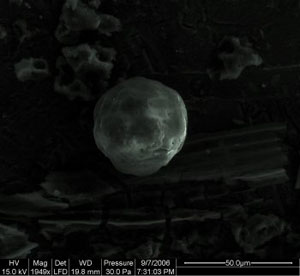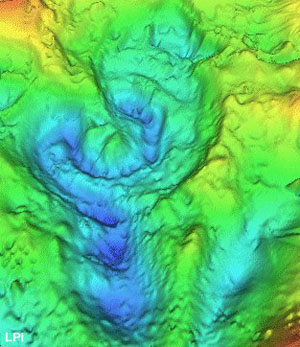Palaeontologists presume that an asteroid impact led to such enormous and widespread environmental upheaval that it wiped out the dinosaurs and thousands of other species when it struck the Earth. Now, researchers from Italy, New Zealand, UK, and USA suggests that the impact force was so great that it would have liquefied carbon in the planet’s crust and sprayed tiny airborne carbon beads into the atmosphere in unimaginable quantities.
Writing in the May issue of the journal, Environ Sci Tech, 2008, in press, Simon Brassell of Indiana University Bloomington, and colleagues Mark Harvey (now a geoscientist for Sinclair Knight Merz in New Zealand), Claire Belcher (University of London, UK) and Alessandro Montanari (Coldigioco Geological Observatory, Italy) describe the formation of these cenospheres. They point out that combustion of plant matter would have been inadequate in creating such vast quantities of these carbon beads. Their findings, contradict an earlier hypothesis that suggested cenospheres are the charred remains of an Earth on fire.

Simon C. Brassell
Carbon embedded in the rocks was vaporized by the [asteroid] impact, eventually forming new carbon structures in the atmosphere, explains Brassell. They were then deposited some 65 million years ago next to a thin layer of the element iridium, which is more abundant in Solar System asteroids than in the Earth’s crust. The researchers add that this iridium-laden dust is the shattered remains of an asteroid impact 200 km wide. In common with the iridium layer, carbon cenospheres are found across the globe, in Canada, Europe, New Zealand, South America, and USA. Until now, cenospheres have been considered a modern phenomenon, associated with industrial activity rather than any natural process. They form during the intense combustion of coal and crude oil.
Carbon cenospheres are a classic indicator of industrial activity, Harvey explains, The first appearance of the carbon cenospheres defines the onset of the industrial revolution. The only possible explanation of cenospheres at asteroid impact sites in such close proximity to iridium-rich dust is that they formed through a previously unknown process, the violent pulverization of the Earth’s carbon-rich crust.

Tiny carbon-rich particles may have played a part in dinosaur death
The researchers examined rock samples from eight marine locations in Denmark, Italy, Spain, and New Zealand, as well as carbon-rich particles from five non-marine locations in the Americas. They also found that the further away from the Chicxulub Crater (the putative impact site of the dinosaur-killing asteroid), the smaller were the cenospheres. Larger particles would not remain airborne for long falling closer to the crater than smaller particles transported on winds further afield.

The Chicxulub Crater (LPI/NASA image)
There are still clues to unravel about the events occurring around the time of the impact, Brassell said. And there are aspects of the Earth’s natural carbon cycle that we didn’t previously consider. If the findings are confirmed, the discovery suggests environmental circumstances accompanying the 65-million-year-old extinction event may have actually been marginally less dramatic than previously thought.
Further reading
Simon C. Brassell
http://www.indiana.edu/~geosci/people/faculty2.php?n=brassell
Astronomy Picture of the Day: Impact! 65 million years ago
http://apod.nasa.gov/apod/ap971012.html
Suggested searches
asteroids